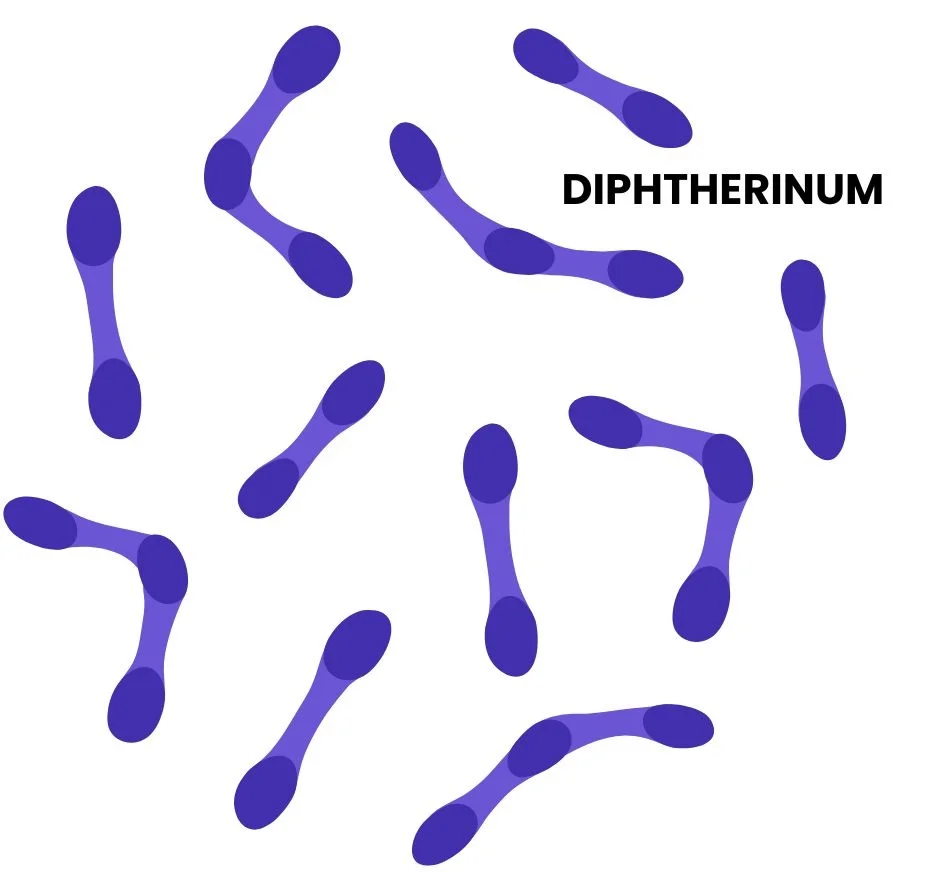Diphtherinum is a homeopathic remedy prepared from the potentized diphtheritic virus.
It is primarily used to treat conditions associated with diphtheria and its lingering effects, such as post-diphtheritic paralysis and chronic respiratory issues.

Table of Contents
ToggleSOURCE INFORMATION
- Scientific Classification: Diphtherinum is classified within the realm of homeopathic remedies prepared from disease products, specifically potentized viruses.
- Origin and Historical Facts: The remedy originates from the pathological product of diphtheria, a bacterial infection caused by Corynebacterium diphtheriae.
- Historically, diphtheria was a severe infectious disease affecting the respiratory tract, characterized by the formation of a thick, greyish membrane in the throat.
Homoeopathic Application
- In homeopathy, Diphtherinum is indicated for patients prone to catarrhal affections of the respiratory organs, particularly those with a scrofulous constitution.
- It is used not only during acute diphtheria but also in the management of post-diphtheritic complications like paralysis.
DRUG PATHOGENESIS
Diphtherinum’s pathogenesis includes symptoms observed in patients suffering from diphtheria and its aftermath:
- Diphtheria Symptoms: Characterized by laryngeal diphtheria, thick and dark membranes in the throat, offensive breath and discharges, swollen glands, and profound prostration.
- Post-Diphtheritic Complications: Such as laryngeal paralysis, where swallowing is painless but fluids may be regurgitated through the nose.
KEY CHARACTERISTICS
- Adapted To: Individuals prone to respiratory catarrhal conditions and those with a scrofulous constitution.
- Primary Conditions: Diphtheria, laryngeal diphtheria, post-diphtheritic paralysis.
- Symptoms: Offensive breath and discharges, swollen glands, thick and dark diphtheritic membrane, epistaxis (nosebleeds), profound weakness and prostration.
DETAILED ORGAN SYMPTOMS
RESPIRATORY SYSTEM
- Laryngeal Diphtheria: Diphtherinum is indicated for cases where there is inflammation and the formation of a thick, dark membrane in the larynx (voice box).
- This membrane can obstruct the airway, causing breathing difficulties and a characteristic hoarse or muffled voice.
- Difficulty Swallowing without Pain: One of the peculiar symptoms of diphtheria is the ability to swallow without pain despite the presence of the membrane.
- This is a notable feature that distinguishes it from other throat infections.
- Regurgitation of Fluids through the Nose: Due to the involvement of the upper respiratory tract, particularly the nasal passages, fluids swallowed may regurgitate through the nose.
- This occurs because the normal passage of fluids into the oesophagus is obstructed by the membrane in the throat.
GASTROINTESTINAL SYSTEM
- Offensive Breath and Discharges: Patients may present with foul-smelling breath, indicative of the toxins produced by the diphtheritic infection.
- Additionally, any discharges from the nose or throat may have a similarly offensive odour.
- Vomiting of Fluids: As part of the profound weakness and prostration experienced by diphtheria patients, there may be vomiting of fluids, especially if there is an attempt to ingest food or liquids despite the difficulty in swallowing.
GENERAL SYMPTOMS
- Swollen Glands: Lymph nodes in the neck and throat region become swollen and tender due to the infection.
- This swelling is part of the body’s immune response to the bacterial toxins.
- Profound Weakness and Prostration: Diphtheria is often accompanied by extreme weakness and a feeling of exhaustion, sometimes to the point of being bedridden.
- This profound weakness is a result of the systemic effects of the infection and the body’s efforts to combat it.
These symptoms collectively paint a picture of a severe respiratory and systemic infection characteristic of diphtheria.
Homeopathically, Diphtherinum is indicated not only during the acute phase of diphtheria but also in cases where there is lingering weakness and other sequelae of the infection, such as post-diphtheritic paralysis.
It is administered in potentized form according to homeopathic principles, aiming to stimulate the body’s innate healing response and restore balance.
MODALITIES
- Aggravation: Symptoms worsen in cold weather or damp conditions.
- Amelioration: Improvement with warmth and rest.
WHAT ARE MODALITIES IN HOMOEOPATHY?
RELATIONSHIP WITH OTHER DRUGS
- Compare: Diphtherotoxin (Cahis) for chronic bronchitis with rales and vago-paralytic forms of bronchitis in the elderly post-influenza.
DOSE
- Potencies commonly used are thirtieth (30C), two hundredth (200C), or even higher (CM potency).
- It is advised not to repeat doses too frequently, as guided by a qualified homeopathic practitioner.
Frequently Asked Questions
What is Diphtherinum used for?
- It is used primarily for treating diphtheria and its sequelae, including post-diphtheritic paralysis.
Is Diphtherinum safe?
- When used according to homeopathic principles and under professional guidance, Diphtherinum is considered safe.
What are the key symptoms indicating Diphtherinum?
- Symptoms include offensive breath and discharges, swollen glands, and profound weakness after diphtheria.
Meaning of Difficult Words
- Catarrhal: Inflammation of a mucous membrane, especially of the respiratory tract, characterized by excessive mucus production.
- Scrofulous: Pertaining to a constitutional tendency toward glandular enlargement, especially of the lymph nodes, and poor resistance to infection.
- Membrane: A thin layer of tissue covering a surface or lining a cavity.
- Regurgitation: The return of swallowed food or liquids into the mouth.
This detailed drug picture of Diphtherinum encompasses its origins, applications, symptoms, and usage in homeopathy, providing a comprehensive understanding of its therapeutic indications and modalities.
